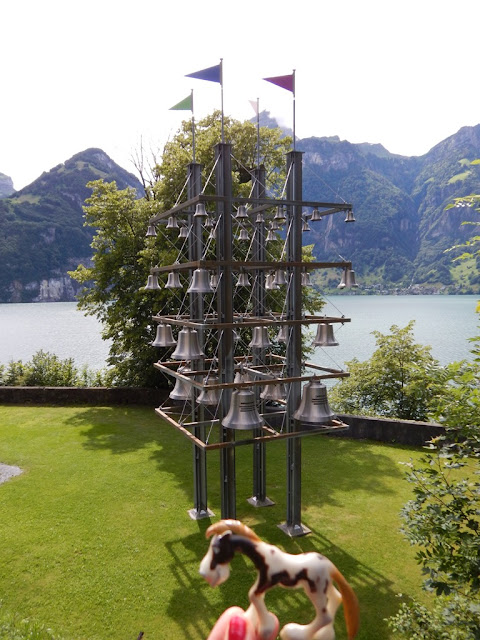We will start our journey in canton Uri, on the shores of the Lake Lucerne. It is one of most beautiful places that I have seen in Switzerland. The lake, the mountains, the blue sky.
What I find really amazing is the colour of the water. Like a precious gem. The white steam ship looks just so well fit into this place.
It is here, on board of the lake that you will find the Tellskapelle or the Tell's Chapel.
We need to go down the hill. We will pass the vineyards, which you are always sure to find on any southern slope in Switzerland.
On our way, we will see also a giant carillon, founded by the Swiss chocolate industry. It plays some music every hour.
Our target is down there, behind the trees.
Here it comes slowly ...
We need to get literally at sea level. Oh, excuse me, at lake level of course.
Wilhelm Tell was a Swiss man who had his pride. He refused to bow in front of the hat of a representative of the Habsburgs who ruled this part of Switzerland in early fourteenth century. You probably recall that the vicious earl made him shoot with a crossbow an apple placed on the head of Tell's son. He then arrested Tell, who managed to escape from a boat taking him to prison. According to the legend, this escape (or leap) took place just here.
To commemorate this escape, Swiss people built a chapel. In 1561, a society was established which held an annual memorial service at the chapel. Over the last centuries the chapel was rebuilt many times, this one was constructed in 1880.
On the upper side of the arches you will find the coats of arm's of the three cantons which have founded Switzerland, by signing the Federal Charter back in 1291 (!). The left one stands for Schwyz, which gave the country its name.
The middle one is that of Uri, where the Charter was signed.
The right one is for Unterwalden, a canton that does not exist any more. No, they did not vote on a Unterwalden exit and left the confederation. It was simply reorganized as two cantons, an upper part called Obwalden, and a lower part called Nidwalden.
In the middle of the chapel you will find of course an altar.
Behind it come frescoes. Unlike in most churches, they do not present saints or scenes from the Bible but the life of Wilhelm Tell and the Swiss confederation. On that one the evil earl orders Tell to shoot an apple on the head of his own son.
Here Tell kills the earl, after having escaped from the boat.
The ceiling is blue, dotted with golden stars. My immediate association is with the colour of the Lake Lucerne.
Unfortunately I did not manage to see the Tell's Chapel from the lake, but if I would be to trust other people's pictures it is really amazing. If you ever have the chance of checking it yourself, drop me a line!
 |
| Source: www.MySwitzerland.com |
I hope that you enjoyed this little journey in time, to the foundation of the Swiss history.


















kolor wody jest po prostu zachwycający! nie mogę oderwać od niego oczu!
ReplyDelete